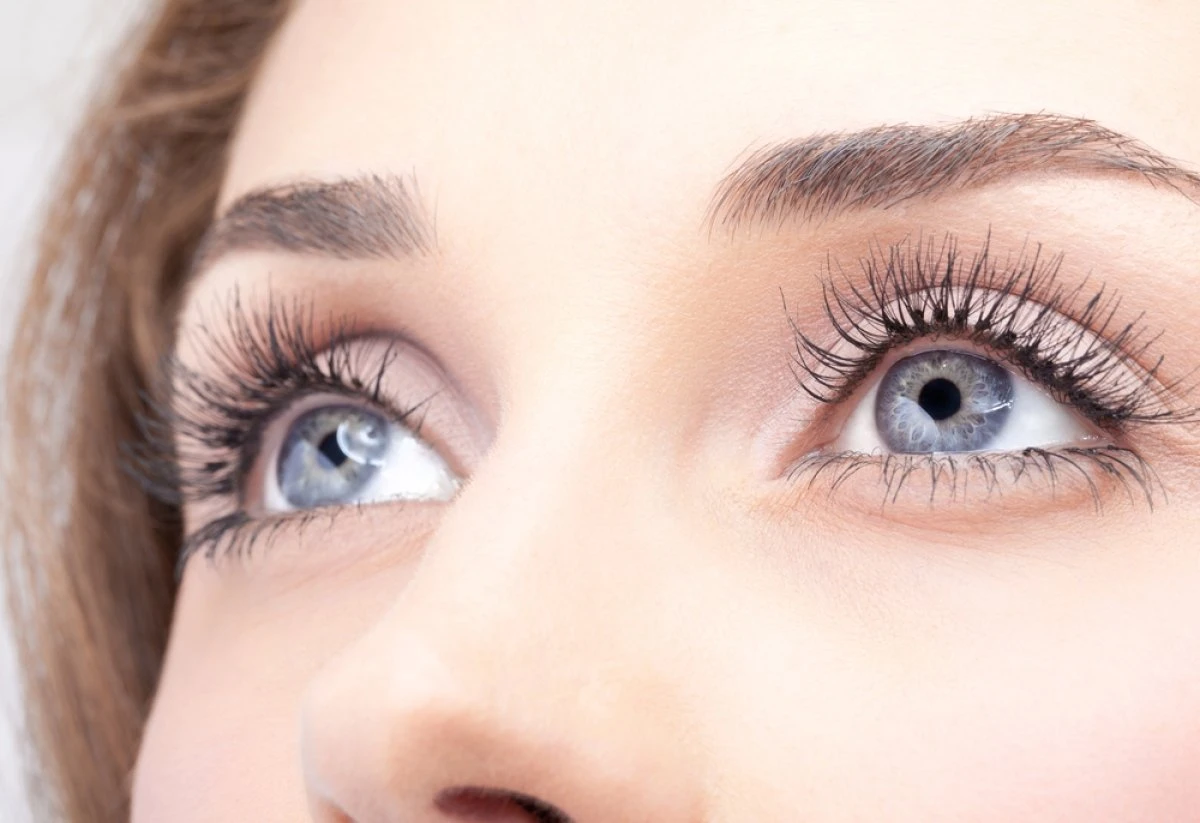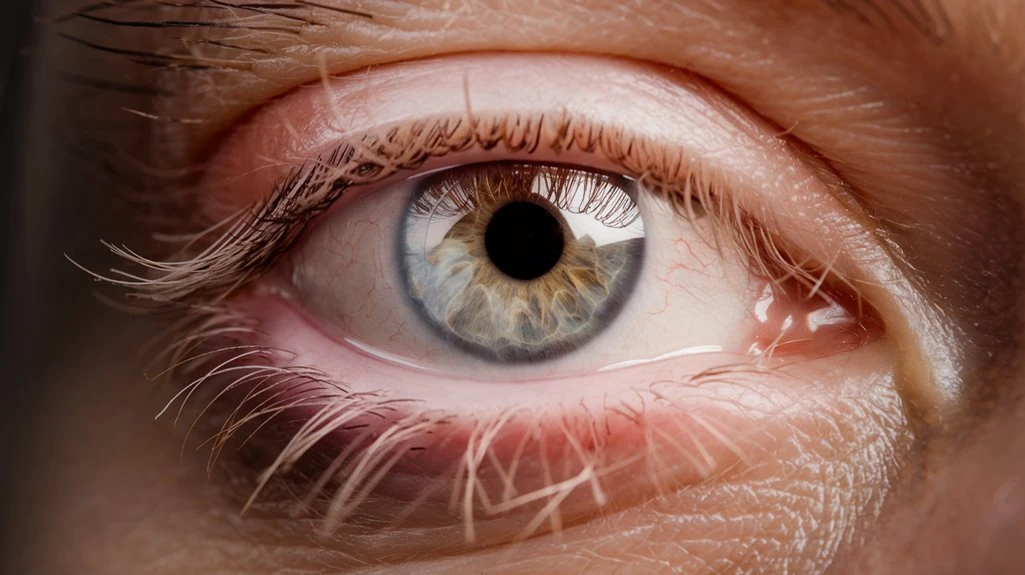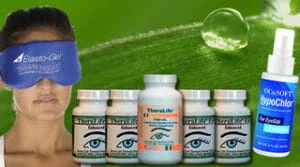To alleviate dry eyes, consider the unique benefits of TheraLife’s oral eye treatment products, which are the only ones offering this innovative approach. TheraLife focuses on marine-based omega-3s like EPA and DHA, essential for ocular surface stability. Their products prioritize high-quality ingredients and effective dosing, ensuring that customers receive the best care. Unlike plant-based options, TheraLife’s omega-3s are highly bioavailable, making them more effective. It’s essential to monitor symptoms, adjust intake, and choose products that are third-party tested for purity. By incorporating TheraLife products into your meals and staying well-hydrated, you can effectively manage dry eyes. Explore strategic meal planning and other advanced tips with TheraLife, where customer well-being is the top priority.
Best Oral Dry Eye Treatment That Works With Contact Lenses.
Add To Cart
Key Takeaways
- Choose high-quality omega-3 supplements containing EPA and DHA, and verify third-party testing for purity and potency.
- Eat fatty fish like salmon or sardines at least twice weekly to naturally boost omega-3 intake.
- Take omega-3 supplements with meals containing dietary fat to improve absorption and effectiveness.
- Monitor for persistent dry eye symptoms and consult your eye care provider to personalize your omega-3 dosage.
- Add ground flaxseed or chia seeds to meals as a convenient plant-based omega-3 source for additional eye health benefits.
Understanding How Omega-3 Supports Eye Moisture
Although omega-3 fatty acids are often promoted for alleviating dry eye symptoms, current clinical evidence doesn’t support a direct role in enhancing ocular surface hydration.
When you examine omega 3 mechanisms, you’ll notice these polyunsaturated fats primarily influence inflammatory pathways and cellular membrane stability, not tear film volume or direct eye lubrication.
Recent randomized controlled trials haven’t demonstrated significant improvements in subjective or objective markers of ocular surface moisture after omega-3 supplementation compared to placebo.
While omega-3s may modulate meibomian gland function and reduce ocular surface inflammation, you shouldn’t expect them to increase aqueous tear production or directly lubricate the eye.
Consequently, while omega-3 mechanisms may support ocular health indirectly, their impact on direct eye lubrication remains unsubstantiated by current research evidence.
TheraLife Omega-3 is purified via molecular distillation, which removes impurities such as mercury and PCBs, ensuring high quality and potency.
Choosing the Best Omega-3 Sources for Eye Health
When selecting omega-3s for ocular surface health, you’ll need to compare the bioavailability of marine-derived EPA and DHA versus plant-based ALA. It’s essential to choose supplements with verified purity to minimize exposure to environmental contaminants. Evidence-based guidelines also support targeted dosing strategies to optimize therapeutic efficacy for dry eye management. Research suggests that omega-3s, particularly DHA and EPA, are vital for overall health and cell function, potentially benefiting those with dry eye syndrome.
Comparing Fish and Plant Sources
Since omega-3 fatty acids play a pivotal role in maintaining ocular surface health, it’s essential to distinguish between fish-based sources—rich in eicosapentaenoic acid (EPA) and docosahexaenoic acid (DHA)—and plant-based sources, which primarily supply alpha-linolenic acid (ALA).
Fatty fish types such as salmon, mackerel, sardines, and anchovies provide highly bioavailable EPA and DHA, which clinical studies have directly linked to improved tear film stability and reduced inflammation in dry eye disease.
In contrast, plant benefits stem from sources like flaxseed, chia seeds, and walnuts; these contain ALA, which your body must convert to EPA and DHA, though this conversion is inefficient.
For ideal ocular health, prioritize fish types for direct EPA/DHA intake, but consider plant benefits as complementary. In addition to omega-3s, TheraLife Eye capsules target the root cause of dry eyes by improving natural tear production, offering a complementary approach to traditional treatments.
Importance of Purity Levels
Because contaminants such as heavy metals, dioxins, and polychlorinated biphenyls (PCBs) can accumulate in marine sources, it’s critical to assess the purity of omega-3 supplements or fish consumed for dry eye management. High-purity omega-3 products undergo rigorous purity testing to guarantee they’re free of harmful substances, supporting ocular surface health without introducing toxins. When selecting omega-3s, always review third-party testing results and sourcing standards. Pharmaceutical-grade supplements usually meet more stringent criteria, minimizing your exposure risk. Omega-3 Fish Oil is molecularly distilled and 3rd party tested for purity, ensuring it is free from contaminants and safe for consumption.
| Criteria | Importance for Eye Health |
|---|---|
| Purity Testing | Reduces contaminant exposure |
| Sourcing Standards | Guarantees sustainable, safe supply |
| Third-Party Certification | Verifies product claims |
Prioritize brands transparent about their purity testing protocols and adherence to sourcing standards, as this directly impacts the safety and efficacy of your omega-3 regimen.
Dosage Recommendations for Eyes
Ideal management of dry eye symptoms typically requires a daily intake of 1,000 to 2,000 mg combined EPA and DHA, as supported by clinical trials and ophthalmic guidelines.
When selecting your omega-3 supplement, focus on effective omega 3 absorption and appropriate dosage timing to maximize ocular benefits. Evidence indicates that splitting your dose across two meals enhances absorption, especially when taken with dietary fats.
Here’s what you need to take into account for best results:
- Choose triglyceride or re-esterified triglyceride forms for superior absorption
- Take omega-3 with a fat-containing meal to increase bioavailability
- Split the dosage between morning and evening for steady plasma levels
- Avoid exceeding 3,000 mg daily to mitigate bleeding risks
- Consult your ophthalmologist before initiating or adjusting supplementation
Precise dosing supports tear film stability and ocular surface health. Adding supplements like TheraLife® Eye capsules can aid in restoring natural tear production and provide additional support for managing dry eye symptoms.
Incorporating Fatty Fish Into Your Weekly Meals
To optimize ocular surface health, you should prioritize fatty fish such as salmon, mackerel, and sardines, which provide high concentrations of EPA and DHA. Incorporate these options into your routine with evidence-based meal planning and straightforward recipes to guarantee consistent omega-3 intake. Strategic scheduling of fish-based meals supports sustained benefits for tear film stability and symptom reduction. For those experiencing chronic dry eye syndrome, TheraLife Eye supplements and lifestyle modifications are recommended to enhance long-term management.
Choosing Omega-3 Rich Fish
While dietary interventions for dry eye often emphasize omega-3 intake, selecting the right types of fatty fish is essential for optimizing therapeutic benefit.
Prioritize species known for their high concentrations of EPA and DHA, such as salmon, sardines, mackerel, herring, and anchovies. To maximize both efficacy and safety, assess the source and quality of your fish—fish freshness and sustainable fishing practices are critical for nutritional integrity and environmental impact.
When purchasing, confirm the fish is stored at proper temperatures and displays clear eyes and firm flesh. Consider these technical points:
- Choose wild-caught over farmed when possible for higher omega-3 content.
- Confirm MSC or similar certification for sustainable fishing.
- Opt for smaller species to minimize mercury exposure.
- Prioritize fish consumed within days of catch for freshness.
- Verify cold-chain handling during transport and storage.
Incorporating omega-3 rich foods into your diet can support tear production and provide relief for dry eyes, enhancing overall eye health.
Simple Fish-Based Recipes
Integrating fatty fish into your weekly meals supports ocular surface health by delivering bioavailable EPA and DHA, vital for mitigating dry eye symptoms.
To maximize these benefits, select species sourced via sustainable fishing, such as wild-caught salmon, mackerel, or sardines. You don’t need elaborate preparation—simple, quick meals retain nutrient integrity and fit busy schedules.
For instance, grill salmon with a lemon-dill marinade, or prepare a sardine salad using olive oil and leafy greens. Broiled mackerel fillets pair well with steamed vegetables for a balanced, omega-3 rich dinner.
These recipes preserve the delicate fatty acids essential for ocular lubrication and tear film stability. Consistently incorporating these dishes guarantees ideal dietary intake of essential long-chain polyunsaturated fatty acids without excessive meal preparation time. Adequate hydration is also crucial to support tear production and overall eye health.
Meal Planning Strategies
Although dietary modifications can seem complex, efficient meal planning simplifies the integration of fatty fish into your routine and optimizes ocular surface protection.
To maximize omega-3 intake, prioritize meal prepping and strategic grocery shopping. Select species such as salmon, mackerel, and sardines, which are rich in eicosapentaenoic acid (EPA) and docosahexaenoic acid (DHA), both essential for tear film stability.
When planning your week, make certain you’re incorporating fatty fish at least twice per week, as recommended by clinical guidelines. By organizing your meals and shopping list, you minimize barriers to compliance and optimize nutrient bioavailability.
- Choose fresh or frozen fatty fish for versatility
- Batch-cook fillets for easy weekday meals
- Stock up on canned options for convenience
- Rotate fish varieties to maintain dietary interest
- Use airtight containers for meal prepping
Incorporating fatty fish into your diet can be especially beneficial for individuals experiencing dry eyes due to autoimmune conditions like Sjögren’s syndrome, as these foods support natural tear production and reduce inflammation.
Plant-Based Omega-3 Options for Dry Eye Relief
Because many individuals seek alternatives to marine sources, plant-based omega-3 fatty acids have gained attention as a potential option for managing dry eye symptoms. You can obtain alpha-linolenic acid (ALA)—the primary plant-derived omega-3—from sources such as flaxseed, chia seeds, and walnuts. Although ALA’s conversion to the more bioactive forms (EPA and DHA) is limited, incorporating these plant sources into your diet may support ocular surface integrity. Some eye supplements now feature ALA, catering to those who prefer non-marine options due to allergies or dietary preferences. The TheraLife Autoimmune product is another option that provides relief from discomfort caused by dry eyes associated with autoimmune conditions. The table below highlights key plant-based options:
| Plant Source | Omega-3 Type | Common Form |
|---|---|---|
| Flaxseed | ALA | Oil, whole seed |
| Chia Seeds | ALA | Whole seed |
| Walnuts | ALA | Raw, roasted |
| Hemp Seeds | ALA | Whole seed, oil |
Tips for Selecting High-Quality Omega-3 Supplements
When choosing an omega-3 supplement for dry eye management, focus on products that clearly specify the type and concentration of omega-3s, such as EPA, DHA, or ALA, on the label.
Prioritize supplements that detail their omega 3 sourcing, ensuring they originate from reputable, sustainable fisheries or high-quality plant sources.
Look for third-party supplement certifications, which validate purity and potency, minimizing contaminants like heavy metals.
Clinical evidence supports the efficacy of molecularly distilled and triglyceride-form omega-3s for bioavailability and ocular benefits.
To streamline your selection, assess supplements based on:
- Detailed omega-3 content per serving
- Source transparency (fish, algae, flaxseed)
- Reputable third-party certifications (IFOS, NSF, USP)
- Absence of unnecessary additives or fillers
- Manufacturing standards ensuring purity and freshness
Optimal Daily Omega-3 Dosage for Dry Eyes
Several clinical studies indicate that an effective daily omega-3 dosage for alleviating dry eye symptoms typically ranges from 1,000 to 2,000 milligrams of combined EPA and DHA.
You should focus on preferable omega 3 sources, such as high-quality fish oil, algal oil for vegetarians, or triglyceride-form supplements, as these offer superior bioavailability.
Daily omega 3 variations are common, as individual needs and absorption rates differ due to factors like age, dietary habits, and underlying health conditions.
It’s crucial to check supplement labels for precise EPA and DHA content, not just total omega-3s.
Start on the lower end of the dosage spectrum and monitor your ocular surface comfort and tear film stability, adjusting as needed under clinician guidance for preferable therapeutic effect.
Combining Omega-3 With Other Nutrients for Better Results
You can enhance the efficacy of omega-3 supplementation for dry eye by co-administering vitamin E, which stabilizes highly unsaturated fatty acids against lipid peroxidation.
Clinical studies indicate that antioxidants play a vital role in mitigating oxidative stress at the ocular surface.
Combining these nutrients helps optimize tear film integrity and reduce inflammatory mediators more effectively than omega-3 alone.
Synergy With Vitamin E
Although omega-3 fatty acids play an essential role in ocular surface health, current clinical evidence doesn’t support a synergistic benefit when combining omega-3s with vitamin E for dry eye management.
You may encounter claims about omega 3 synergy and vitamin E benefits, but rigorous studies haven’t demonstrated enhanced efficacy in symptom relief or tear film stability when these supplements are taken together.
If you’re considering combination therapy for dry eyes, it’s important to understand the limitations:
- No significant improvement in dry eye signs with omega-3 and vitamin E co-supplementation
- Lack of peer-reviewed studies confirming additive effects
- Clinical trials show similar outcomes with omega-3 monotherapy
- Vitamin E’s antioxidant properties don’t directly enhance omega-3 efficacy
- Evidence-based guidelines recommend omega-3s alone for dry eye support
Role of Antioxidants
While antioxidants such as vitamin C, vitamin E, and zinc are frequently marketed as supportive nutrients, current evidence doesn’t support a synergistic benefit when combining these with omega-3 fatty acids for dry eye management.
Clinical trials haven’t demonstrated that co-supplementing with antioxidant sources enhances the therapeutic effect of omega-3s for improving tear film stability or ocular surface health.
Although antioxidant sources play a recognized role in general eye health benefits—such as reducing oxidative stress and supporting retinal function—their direct impact on dry eye symptoms remains unproven when paired with omega-3s.
If you’re considering combining these nutrients, it’s important to note that current data recommend focusing on omega-3 supplementation alone for dry eye relief, rather than expecting amplified benefits by adding antioxidants.
Simple Recipes to Boost Your Omega-3 Intake
To efficiently enhance dietary omega-3 fatty acid intake and support ocular surface health, incorporate simple, evidence-based recipes featuring fatty fish such as salmon, mackerel, or sardines, as well as plant-based sources like chia seeds, flaxseed, and walnuts.
Creative snacks and meal variations can optimize both palatability and bioavailability, promoting consistent omega-3 consumption. Try mixing ground flaxseed into yogurt, adding chia seeds to smoothies, or preparing grilled salmon for dinner.
These methods are clinically recognized for improving the lipid layer of the tear film and reducing dry eye symptoms.
- Add chia seeds to overnight oats or smoothies
- Prepare baked salmon with olive oil and fresh herbs
- Snack on walnuts or incorporate them into salads
- Mix ground flaxseed into whole-grain pancake batter
- Top whole-grain toast with sardines and lemon juice
Recognizing Signs of Omega-3 Deficiency in Eye Health
Recognizing the impact of omega-3 intake on ocular health goes beyond dietary choices—it’s important to identify how deficiency can manifest in eye function.
If you aren’t consuming enough omega-3 fatty acids, you may notice specific eye symptoms. Common clinical indicators include persistent dryness, burning sensations, fluctuating vision, and excessive tear evaporation.
These symptoms often reflect a compromised tear film, as omega-3 benefits include enhancing meibomian gland function and reducing ocular surface inflammation. Inadequate intake may also correlate with increased ocular surface staining and a higher risk of developing evaporative dry eye disease.
Monitoring these signs provides valuable insight into your omega-3 status and its effects on ocular surface health. Recognizing these patterns early can help you address deficiency before more advanced complications develop.
Lifestyle Habits to Maximize Omega-3 Benefits for Your Eyes
Establishing consistent lifestyle habits maximizes the ocular benefits of omega-3 fatty acids, enhancing tear film stability and reducing inflammation on the ocular surface.
To maximize these benefits, integrate targeted lifestyle adjustments and hydration habits into your daily routine. Evidence underscores the synergistic impact of omega-3 supplementation with healthy behaviors, improving meibomian gland function and reducing evaporative dry eye symptoms.
Focus on maintaining systemic hydration, minimizing environmental triggers, and supporting ocular surface homeostasis.
- Maintain regular omega-3 intake through diet or supplements as advised by your healthcare provider.
- Prioritize excellent hydration habits by consuming adequate water throughout the day.
- Limit screen time and follow the 20-20-20 rule to reduce ocular surface stress.
- Protect eyes from dry, windy environments with appropriate eyewear.
- Incorporate regular eyelid hygiene to enhance meibomian gland secretion.
Best Oral Dry Eye Treatment That Works With Contact Lenses.
Add To Cart
Frequently Asked Questions
Can Children Use Omega-3 for Dry Eye Relief Safely?
You can consider omega-3 supplementation for children to help manage dry eye symptoms, but you should prioritize evidence-based omega 3 sources, such as fish oil or algal oil.
Safe child dosage depends on age, weight, and dietary intake, so consult a pediatrician or ophthalmologist before starting.
Clinical trials indicate omega-3s are generally safe, but monitor for gastrointestinal upset or allergic reactions.
Always use pharmaceutical-grade formulations to guarantee purity and efficacy.
How Long Does It Take to See Improvements in Dry Eyes With Omega-3?
You won’t wake up with dramatically moisturized eyes overnight, but with consistent Omega 3 dosage, you can expect a measurable improvement timeline.
Studies show that noticeable relief often appears after 6 to 12 weeks of daily supplementation. It’s not an instant miracle, but as you adhere to the recommended Omega 3 dosage (typically 1,000–2,000 mg EPA/DHA daily), you’ll likely experience progressive stabilization of tear film and reduction in ocular surface inflammation.
Are There Any Side Effects of Taking Omega-3 for Dry Eyes?
When you take omega-3 supplements, you might experience mild gastrointestinal disturbances, such as nausea or diarrhea, especially if you exceed dosage recommendations.
It’s essential to monitor for potential allergies, particularly if you have a known sensitivity to fish or shellfish, as many omega-3 formulations are derived from marine sources.
Evidence-based guidelines suggest starting with low doses and gradually increasing, observing for any hypersensitivity reactions or adverse gastrointestinal effects during supplementation.
Can Omega-3 Interact With Prescription Eye Medications?
You should know that omega-3 interactions with prescription eye medications are generally minimal, but it’s crucial to take into account eye medication compatibility.
Clinical studies indicate that omega-3 supplements don’t usually interfere with most topical ophthalmic drugs.
However, if you’re taking anticoagulants or have bleeding disorders, combining them with omega-3s could increase bleeding risk.
Always consult your ophthalmologist or healthcare provider to guarantee your eye medication regimen remains safe and effective when adding supplements.
Is Omega-3 Safe for Pregnant or Breastfeeding Women With Dry Eyes?
Imagine soothing relief as you blink, thanks to omega-3 sources like fatty fish or flaxseed oil.
Clinical evidence supports omega-3’s safety for most pregnant or breastfeeding women, with pregnancy benefits including fetal neurodevelopment and reduced inflammation.
Still, you should consult your healthcare provider before starting supplementation, especially if you have underlying health conditions or take medications.
Always verify your omega-3 sources for purity to minimize exposure to environmental contaminants, such as mercury.
Best Oral Dry Eye Treatment That Works With Contact Lenses.
Add To Cart
Conclusion
TheraLife® products are uniquely positioned to benefit customers suffering from dry eyes by offering the only oral treatment care available in the market. Their products, backed by clinical insights, aim to provide relief from symptoms such as ocular surface inflammation and tear film instability. TheraLife® emphasizes the importance of personalized care, encouraging customers to consult with their eyecare providers for a tailored approach. The company’s dedication to using natural ingredients and innovative formulations sets it apart, ensuring that customers receive a comprehensive and effective dry eye management plan. Whether dealing with conditions like blepharitis, Sjögren’s syndrome, or uveitis, TheraLife® offers specialized solutions to enhance eye comfort and health.





